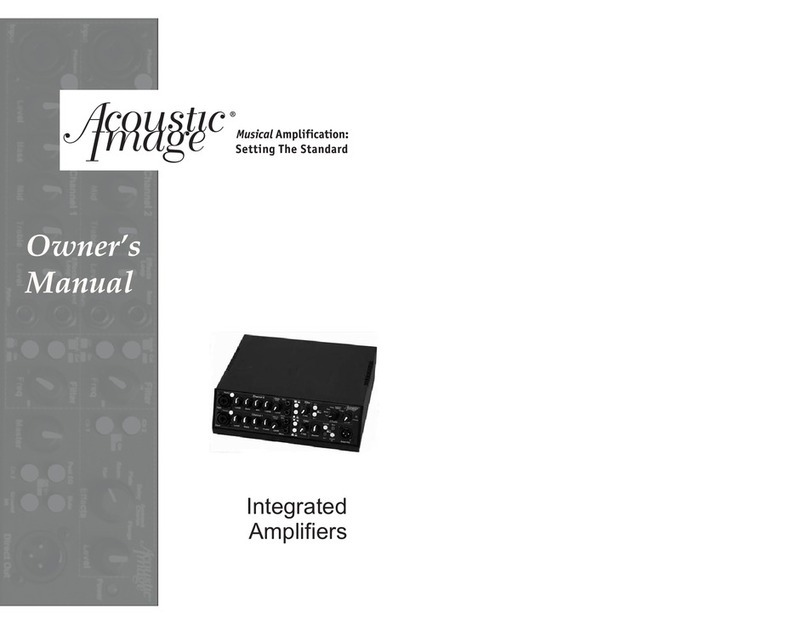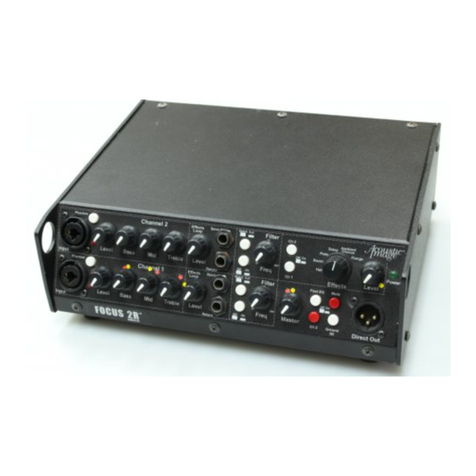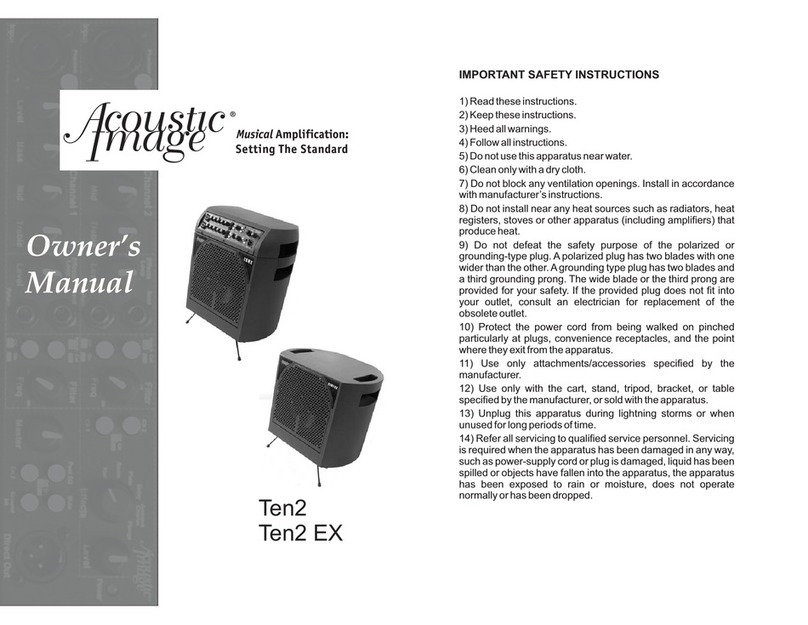Welcome
The Basics 1
Operation--Amp Head 3
Power 3
Preamp 3
Inputs 4
Controls 4
5
Stereo Operation 7
8
Pseudo Stereo Operation 8
Headphone Output 8
Limiter Switch 11
Internal Jumper Options 11
Power Amp 12
Connecting a Speaker 12
Operation with No Speaker 12
Operation--Speaker Cabinets 13
Docking System 13
Speaker Placement 13
Tilt Mechanism 13
Connecting an Extension Speaker 14
Presence Switch 14
Description of the Corus Combo 14
Tweeter Level Control 15
Room Coupling Control 15
Description of the Ten2 EX 15
Care 19
Warranty And Repair 19
Low Cut Filter/Phase Reverse
Effects Loop 6
Direct Out 6
Mute Switch 7
Preamp Output 7
Effects
Control Panel Drawing 9
Signal Flow Diagram 9
Specifications 16
Shoulder Strap 18
Contents
The information in this manual is subject to change without notice. No part of this manual may be
reproduced by mechanical, electronic or other means in any form without prior written permission from
Acoustic Image.
The Acoustic Image logo is a registered trademark ofAcoustic Image LLC. Coda, Corus, Coda EX , Corus
EX, Ten 2, Ten2 EX, Clarus and Cabrio Docking System are trademarks of Acoustic Image LLC.
1
Welcome to Acoustic Image!
You have purchased a state-of-the-art musical instrument amplifier
system, combining purity, power and portability in a package that sets
a new standard in high fidelity amplification.
Each of our designs is engineered to accurately reproduce the sound
of acoustic and electric instruments, delivering flat frequency
response across the entire musical spectrum; extended, tight, well-
controlled bass; and complete clarity of sound reproduction.
This manual provides operating information for your Acoustic Image
Series 4plus Clarus head, Coda, Corus and Ten2 combo; and Coda
EX, Corus EX and Ten2 EX extension cabinet.
The Basics
Our Series 4plus product line consists of a two channel amp head and
three speaker cabinets. The head mounts in the cabinets using our
exclusive Cabrio Docking System to form three different combo amps.
The Clarus amp head uses a class-D power amplifier with a switch
mode power supply and a sophisticated, sensitive two channel
preamplifier. The speaker cabinets have a 1x10 or 2x10 speaker
configuration. The features of the speaker configuration define the
specific combo model. The Coda combo has a 1x10 speaker
configuration with a poly cone woofer. The Corus combo has a 1x10
speaker configuration with a paper cone woofer. Both have a 5 inch
extended range driver with presence control in addition to the woofer.
The Ten2 combo uses a 2x10 speaker configuration (one downfiring,
one front firing) with poly cone woofers in conjunction with a 2.5 inch
tweeter. Each cabinet type is also available as an extension speaker
in either a “Cabrio-ready” configuration or as a fixed extension cabinet
(Coda EX, Corus EX or Ten2 EX).
The features of the S4plus Clarus amp head are:
-Extended frequency range, high fidelity sound
-Light weight (<4 lbs.), small size (10.2 x 8.2 x 3.5)
-Unique, slanted front chassis
-Capable of being mounted in our Coda, Corus or Ten2
speaker cabinets
-Separate XLR and 1/4 inch inputs per channel
-48V phantom power and 10 dB gain select for mic input
-Input level control per channel
-Four band EQ per channel
-Selectable phase reverse and sweepable low cut filter per
channel (phase reverse can be converted to low pass
speaker emulation filter with internal jumper option
-Effects loop per channel
-Selectable reverb and delay effects with level and rate
controls and pseudo stereo output
-Direct out with selectable 10 dB pad, pre/post switch and
ground lift

































